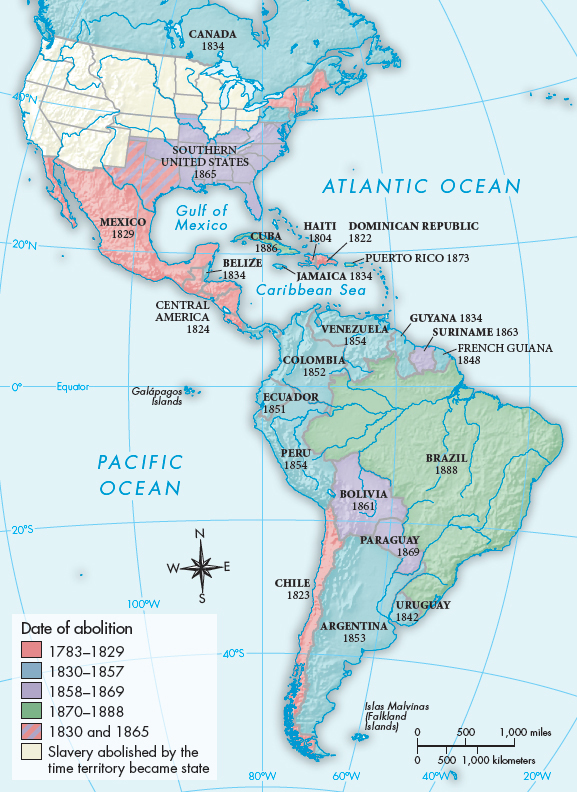Independence and Abolition
Slavery and abolition became intertwined with the process of political independence. The different relationships between independence and abolition in the United States and Haiti shaped perceptions across the rest of the continent. In Haiti national independence was achieved amid a social revolution in which slaves turned against their oppressors. By contrast, the United States gained its independence in a war that created a liberal political regime that preserved the institution of slavery. When colonial elites elsewhere on the continent contemplated independence, they weighed whether the U.S. or the Haitian experience awaited them. As a result, in colonies where the unfree population was the largest, independence movements proceeded more gradually.
British efforts to keep their North American colonies, as well as a combination of moral and economic appeals for the abolition of slavery in British territories, hastened the end of the slave trade to the Americas. When British forces fought to prevent the independence of the United States, they offered freedom to slaves who joined them. Many slaves did so, and after the British defeat and withdrawal, they dispersed to Spanish Florida, the Caribbean, and West Africa.
In 1808 British abolitionists pressured their government to end the Atlantic slave trade to British colonies, and in 1834 Britain abolished slavery in Canada and its Caribbean colonies. In order to reduce economic competition with other countries still importing slaves and still using slave labor, the British government pressured other nations to follow suit. A British naval squadron patrolled the Atlantic to suppress the slave trade. The squadron captured slave ships, freed the slaves they carried, and resettled them in a colony the British government established in Sierra Leone in 1787 to settle former slaves who had sided with Britain in the American Revolution.
Unlike in the United States, in Spanish America independence forces enlisted the participation of slaves and offered freedom in return. As rebels triumphed, new national governments enacted gradual abolition. The first step toward abolition was typically taken through free womb laws that granted freedom to children born to slaves. These laws, passed across independent Spanish America between 1811 and 1825, created gradual abolition but did not impose an immediate financial loss on slaveholders. Similar laws hastened the abolition of slavery in the Northern states of the United States.

In Spanish America the conflicts that continued after independence accelerated the abolition process: within the cycle of violence and civil wars, rival factions competed to enlist the support of slaves and free blacks. In 1854 Peru became the last country in Spanish America to fully abolish slavery. The combination of free womb laws and manumission as a reward for military service meant that, unlike in the United States, by the time slavery was abolished in Latin American countries, most blacks had already gained their freedom (Map 27.2).
In the United States, even if independence occurred without abolition, the questions of nation building and slavery remained connected. The determination of Southern states to protect the slave regime was enshrined in the U.S. Constitution, which granted individual states considerable autonomy in such questions as slavery and freedom. As slavery was abolished in Northern states, westward expansion tested the political compromise between the North and South, culminating in the Civil War.
Tensions between the North and the South reached a breaking point when Abraham Lincoln, committed to checking the spread of slavery, was elected president in 1860. Southern political leaders, fearing that Lincoln might abolish slavery, seceded and formed a new nation, the Confederate States of America. Lincoln declared the secession illegal and declared war on the seceding states to preserve the territorial integrity of the United States. The ensuing civil war resulted in the deaths of over 750,000 combatants and civilians.
The Emancipation Proclamation, which became effective January 1, 1863, abolished slavery in all states that remained opposed to the Union. It was intended as leverage to bring the rebel states back into the Union, not to abolish slavery altogether, because it freed slaves only in states that had seceded. Nevertheless, the proclamation hastened the demise of slavery. In 1865 Southern rebel states surrendered after Northern armies decimated their industrial, agricultural, and military capacity. Months later, the Thirteenth Amendment to the Constitution fully abolished slavery.
Two aspects made slavery in the United States different from slavery in Latin America: gradual abolition in the North made it a regional rather than a national institution, and the U.S. Civil War, followed by military occupation of the South (1865–